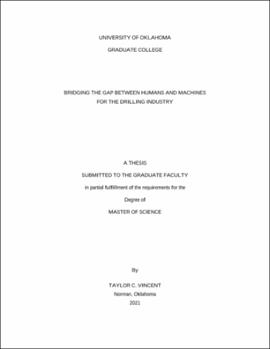| dc.contributor.advisor | Teodoriu, Catalin | |
| dc.contributor.author | Vincent, Taylor | |
| dc.date.accessioned | 2021-12-16T19:18:44Z | |
| dc.date.available | 2021-12-16T19:18:44Z | |
| dc.date.issued | 2021-12-18 | |
| dc.identifier.uri | https://hdl.handle.net/11244/332340 | |
| dc.description.abstract | Drilling is perhaps the most revolutionary advancement humanity has ever experienced. Since its invention, man has seen extraordinary and rapid improvements in quality of life. At the core of drilling’s rapid evolution are the deep motivations for improving performance, profit margins, and efficiency. But with all of the advances also comes more significant risks to humans and more demanding operational settings. One issue of late is the growing divide between drilling technologies and the humans who invented them. Human involvement in the drilling process is dramatically decreasing while all the new technological solutions keep moving in. Yes, machines and technology might be bearing more of the workload, but there will always be a need for humans during the drilling process – invention, input, intervention, and termination. Furthermore, as long as companies continue to preach “safety” and “efficiency,” there will always be a requirement for keeping humans in the loop of drilling’s future innovations.
This thesis spans many essential topics from both sides of this growing divide. Perspectives helping push the human-centric concept forward include practical applications borrowed from cognitive psychology, design, human factors engineering, and crew resource management. The machine perspective is a review of drilling simulators and mathematical approaches, plus a proposal of the future of drilling machines due to spec-driven technological requirements and future drilling applications. This thesis also presents a series of drilling simulator experiments that test humans' communication and attention abilities, and the cumulative results suggest that the drilling industry might benefit from a standardized or universal drilling language. This thesis concludes with ideas for future research and a new framework to adopt. Above all, this thesis encourages a new paradigm that promotes innovation while bridging the gap between humans and drilling machines. | en_US |
| dc.language | en_US | en_US |
| dc.rights | Attribution-NoDerivatives 4.0 International | * |
| dc.rights.uri | https://creativecommons.org/licenses/by-nd/4.0/ | * |
| dc.subject | Universal Drilling Language | en_US |
| dc.subject | human factors | en_US |
| dc.subject | human machine interaction | en_US |
| dc.subject | drilling simulators | en_US |
| dc.title | Bridging the Gap Between Humans and Machines for the Drilling Industry | en_US |
| dc.contributor.committeeMember | Gronlund, Scott | |
| dc.contributor.committeeMember | Ahmed, Ramadan | |
| dc.date.manuscript | 2021-12-12 | |
| dc.thesis.degree | Master of Science | en_US |
| ou.group | Mewbourne College of Earth and Energy::Mewbourne School of Petroleum and Geological Engineering | en_US |

